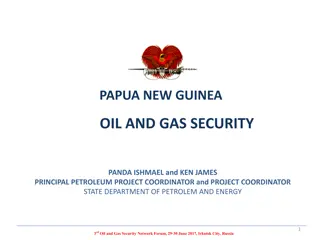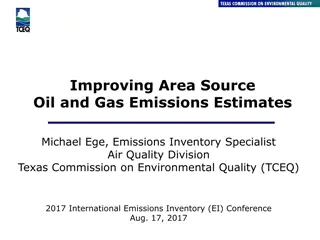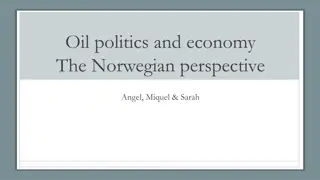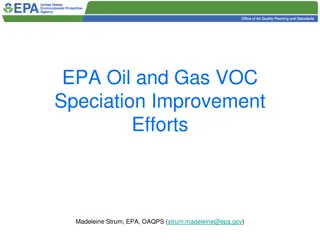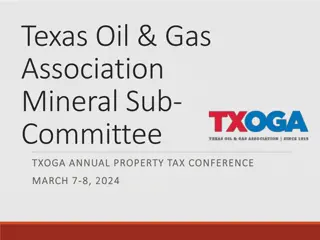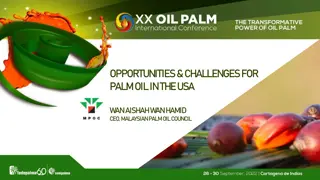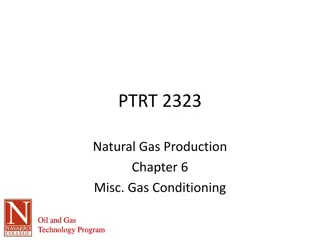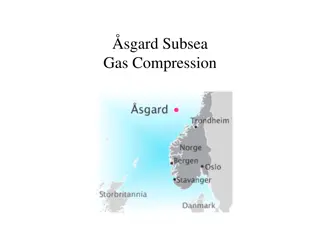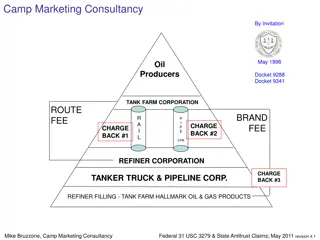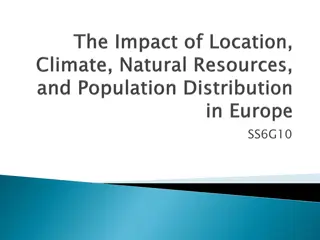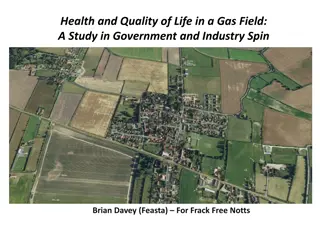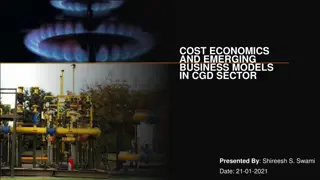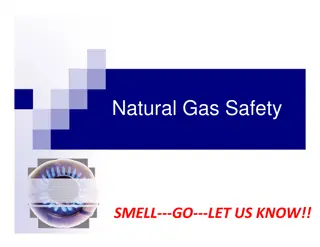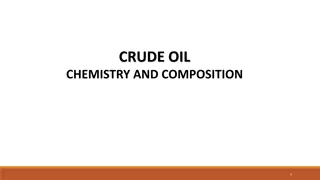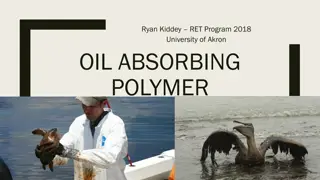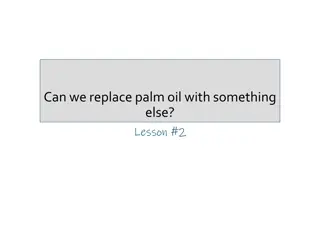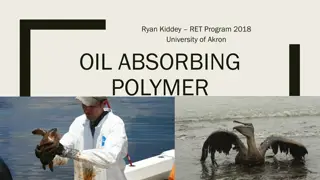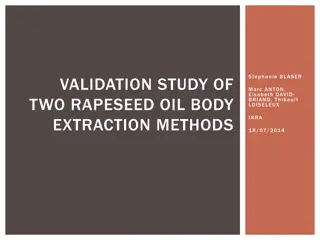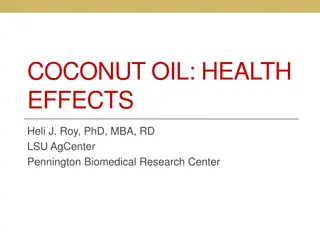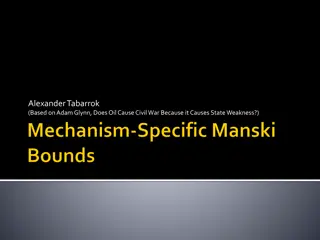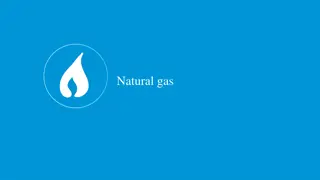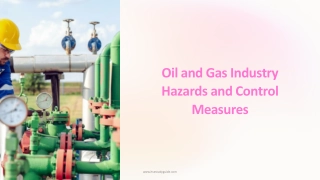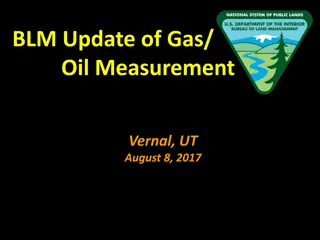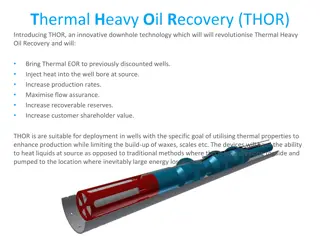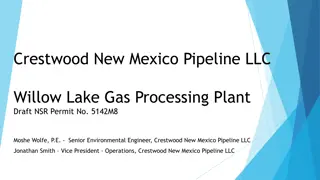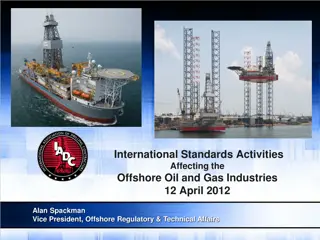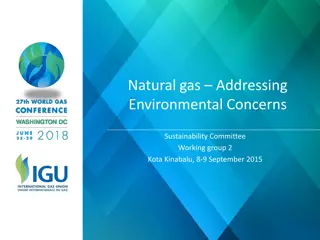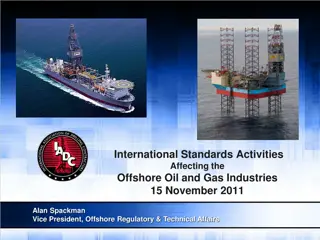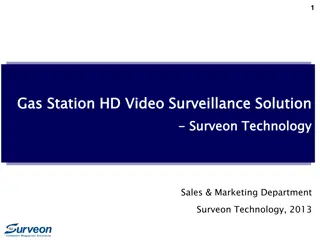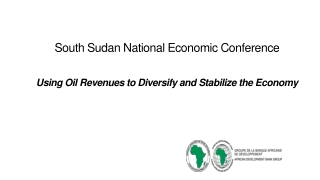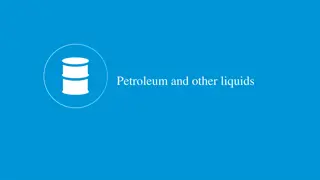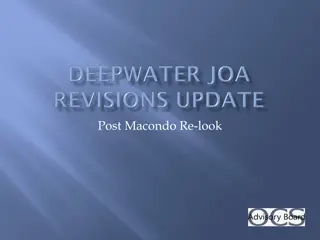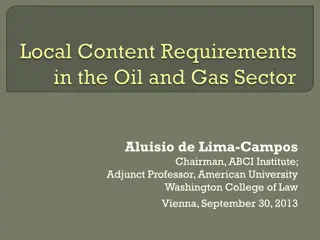Oil and Natural Gas Sector New Source Performance Standards
The Oil and Natural Gas Sector is introducing new performance standards for small entities. The consultation includes background information, regulatory history, and potential control strategies to reduce methane emissions. Small entity representatives are encouraged to provide feedback on the proposed regulations to ensure regulatory flexibility and compliance with the Clean Air Act.
Download Presentation

Please find below an Image/Link to download the presentation.
The content on the website is provided AS IS for your information and personal use only. It may not be sold, licensed, or shared on other websites without obtaining consent from the author. Download presentation by click this link. If you encounter any issues during the download, it is possible that the publisher has removed the file from their server.
E N D
Presentation Transcript
Oil and Natural Gas Sector New Source Performance Standards Small Entity Representative Pre-Panel Outreach June 2021
Overview Background Consultation with Small Entity Representatives Clean Air Act Section 111 Emissions Standards Regulatory History Executive Order on Protecting Public Health and the Environment Sector Overview Methane Emissions in the Oil and Natural Gas Sector Small Business Size Definitions Scope of the 2021 Proposal Current Applicability and Requirements Potential Control Strategies Cost Estimates (2019$) Other Federal Regulations Schedule Input Requested Contact information June 22, 2021 2
Consultation with Small Entity Representatives EPA is interested not only in information, but also in advice and recommendations from the small entity representations (SERs) EPA will use this information to develop a regulatory flexibility analysis, which becomes part of the record for the potential regulation Key elements in this analysis: Number of small entities to which the potential rule would apply Projected compliance requirements of the potential rule Identification of all relevant federal rules that may duplicate, overlap or conflict with the potential rule Any significant alternatives to the potential rule that accomplish the stated objectives and that minimize significant economic impact of the potential rule on small entities June 22, 2021 3
SERs and the Regulatory Process We are seeking information on how the options presented might affect your business or organization Provide specific examples of impacts Provide cost data, if available We are also seeking input on regulatory alternatives that still accomplish the objectives of the Clean Air Act Suggest other relevant control strategies, including data on their costs, effectiveness, and information on how to ensure compliance The Regulatory Flexibility Act (RFA) suggests flexibilities, such as exemptions, different compliance timetables, and simplified reporting requirements We would like to minimize duplication Provide information on any potentially duplicative or contradictory federal, state, or local regulations. June 22, 2021 4
Clean Air Act Section 111 Emissions Standards For source categories that cause or contribute significantly to air pollution which may reasonably be anticipated to endanger public health or welfare, Section 111 of the Clean Air Act requires that EPA establish standards of performance for new sources and, for certain pollutants, issue regulations under which states establish standards of performance for existing sources. Standards must be set based on what is achievable through the application of the best system of emission reduction (BSER) To determine BSER, EPA must consider: Cost (must not be exorbitant, greater than the industry can bear, or unreasonable ) Non-air quality health and environmental impacts Energy requirements Technology that has been adequately demonstrated When issuing regulations for existing sources, EPA allows states to take into account the remaining useful life of those sources, and other factors, in applying standards of performance in their state plans June 22, 2021 5
Regulatory History 2012 NSPS OOOO regulated VOC emissions from several sources in the production and processing segments 2016 NSPS OOOOa added methane as a regulated pollutant and expanded regulations through the transmission and storage segment. NSPS OOOOa also added requirements to cover additional sources; included fugitive emissions monitoring 2020 Policy Rule removed the transmission and storage segment from OOOO and OOOOa and rescinded methane standards in the production and processing segments 2020 Technical Rule exempted low production well sites from fugitive emissions monitoring, decreased monitoring frequency at compressor stations to semi-annually, allowed compliance with state requirements as an alternative to fugitive emissions requirements June 22, 2021 6
Executive Order on Public Health and the Environment On January 20, 2021, President Biden issued Executive Order 13990, Protecting Public Health and the Environment and Restoring Science to Tackle the Climate Crisis Among other direction to EPA, the order instructs EPA to consider taking two actions by September 2021 focused on reducing methane emissions from the oil and gas sector: Propose strengthening previously issued standards for new sources Propose emission guidelines for existing operations in the oil and gas sector These actions both fall under section 111 of the Clean Air Act 7 June 22, 2021
Oil and Gas Sector Overview The NSPS has generally characterized industry operations as being composed of four segments : Production of Oil and Natural Gas Natural Gas Processing Natural Gas Transmission Natural Gas Storage In the U.S. there are over 15,000 oil and gas owners and operators and the large majority are small entities Around one million producing onshore oil and gas wells About 5,000 gathering and boosting facilities Over 650 processing facilities About 1,400 transmission compression facilities Over 900 transmission pipeline facilities Over 400 underground natural gas storage facilities Over 100 liquefied natural gas storage or import/export facilities June 22, 2021 8
Oil and Gas Sector Overview Oil Production Storage tanks Pneumatic controllers Well completions Equipment leaks Pneumatic pumps Natural Gas Production & Processing Storage tanks Well completions Pneumatic controllers Processing plant leaks Compressors Equipment leaks Pneumatic pumps Crude oil sent to petroleum refinery (not covered by Oil and Gas NSPS) Natural Gas Transmission and Storage Storage tanks Compressors Equipment leaks Pneumatic controllers Natural Gas Distribution Has never been covered under the NSPS Source: Adapted from American Gas Association and EPA Natural Gas STAR Program 9 June 22, 2021
Methane Emissions: Oil and Natural Gas Sector 10 June 22, 2021
Methane Emissions: Oil and Natural Gas Production 11 June 22, 2021
Methane Emissions: Natural Gas Processing 12 June 22, 2021
Methane Emissions: Transmission and Distribution 13 June 22, 2021
Industry Sectors and Their Small Business Size Definitions Industry sectors included in the source category as defined by North American Industry Classification System (NAICS) NAICS Description Size Standard 211120 Crude Petroleum Extraction 1,250 employees 211130 Natural Gas Extraction 1,250 employees 213111 Drilling Oil and Gas Wells 1,000 employees Support Activities for Oil and Gas Operations 213112 $41.5M in annual revenues 486210 Pipeline Transportation of Natural Gas $30.0M in annual revenues Note: The list of NAICS is not exhaustive June 22, 2021 14
Estimated Number of Facilities Work is ongoing to determine affected facility counts for the NSPS The following table illustrates small business concentrations in the broader oil and natural gas industry Small business percentage NAICS Description Total firms 211120 Crude Petroleum Extraction 4,461 98.8 99.0% 211130 Natural Gas Extraction 617 92.9 93.7% 213111 Drilling Oil and Gas Wells 1,725 98.1% Support Activities for Oil and Gas Operations 213112 8,487 96.7 97.1% 486210 Pipeline Transportation of Natural Gas 128 31.3 39.8% Source: Statistics of U.S. Businesses, United States Census Bureau (https://www.census.gov/data/tables/2018/econ/susb/2018-susb- annual.html; https://www.census.gov/data/tables/2017/econ/susb/2017-susb-annual.html) Notes: Data are from most recent year available, which is 2018 for NAICS codes 211120, 211130, and 213111 and 2017 for NAICS codes 213112 and 486210. Small business percentage ranges reflect overlap between the SUSB Enterprise Size ranges and the SBA size classifications. June 22, 2021 15
2021 Proposal As directed by Executive Order 13990, this proposal will include comprehensive new source performance standards for methane and volatile organic compound (VOC) emissions and emission guidelines for methane emissions The proposal will cover exploration and production, transmission, processing, and storage segments New studies and data are available that may indicate the need for EPA to reevaluate the emissions sources considered since the 2015 OOOOa proposal While the Executive Order directs EPA to issue proposals for both new and existing sources, this Panel is focused only on the NSPS because it directly regulates small entities, while the proposed emission guidelines will only provide requirements to states EPA may convene a separate SBAR Panel on the emission guidelines during development of a Federal Implementation Plan June 22, 2021 16
Scope of the 2021 Proposal Fugitive Emissions Centrifugal Compressors Reciprocating Compressors Pneumatic Controllers Pneumatic Pumps Equipment Leaks at Natural Gas Processing Plants Storage Vessels Well Completions Reporting and Recordkeeping June 22, 2021 17
Fugitive Emissions (part 1 of 2) Applicability New, modified or reconstructed well sites Well sites are modified when a new well is drilled or an existing well is hydraulically fractured or refractured Exempts wellhead only well sites New, modified or reconstructed compressor stations Compressor stations are modified when an additional compressor is installed or an existing compressor is replaced with by one with greater horsepower Excludes compressors at well sites or processing plants from the definition of a compressor station Current requirements Develop an emissions monitoring plan Monitoring can be done using optical gas imaging (OGI) or Method 21 Monitoring surveys must be done semi-annually except for facilities on the Alaska North Slope, which have annual monitoring requirements Exempts low production wells (less than 15 barrels per day) Leaks must be repaired and resurveyed EPA has deemed that compliance with state programs in California, Colorado, Ohio, Pennsylvania, Texas, and Utah is equivalent to OOOOa, provided certain conditions are met June 22, 2021 18
Fugitive Emissions (part 2 of 2) Potential control strategies Consider new technologies that may identify large emission events (e.g., aircraft, satellites) to target site-level monitoring Use site-level emissions to guide monitoring frequency (frequency based on different emission levels instead of production-based frequencies) Unit-level cost estimates from selected regulatory options in OOOOa Capital Cost Annual Cost* VOC $/ton Methane $/ton Non-low Production Well sites $1,026 $2,527 $4,324 $1,202 Gathering and Boosting Compressor Stations $3,087 $12,629 $2,632 $732 * Includes monitoring surveys, cost of repair and resurvey, recordkeeping and reporting costs, and the amortized capital cost over 8 years at 7 percent interest June 22, 2021 19
Centrifugal Compressors Current requirements Centrifugal compressors using wet seals must reduce emissions from the wet seal fluid degassing system by routing to a control device or process Control devices can include combustion control devices, flares, boilers, process heaters, thermal or catalytic vapor incinerators, and carbon adsorption systems Exempt compressors located at well sites Potential control strategies Reevaluating the current requirements to determine if they continue to be the best system of emission reduction Considering whether applicability is appropriately defined Unit-level cost estimates from selected regulatory options in OOOO and OOOOa Capital Cost Annual Cost* VOC $/ton Methane $/ton Processing $80,822 $123,011 $6,306 $569 Transmission $80,397 $127,844 $31,030 $859 Storage $80,397 $127,844 $41,558 $1,151 * Assumes a 7 percent interest rate over equipment lifetime June 22, 2021 20
Reciprocating Compressors Current requirements Replace rod packing every 26,000 hours or 36 months, or collect emissions under negative pressure and route to a process Exempt compressors located at well sites Potential control strategies Reevaluating the current requirements to determine if they continue to be the best system of emission reduction Considering whether applicability is appropriately defined Unit-level cost estimates from selected regulatory options in OOOO and OOOOa Capital Cost Annual Cost* VOC $/ton Methane $/ton Gathering & Boosting $6,362 $1,986 $1,044 $290 Processing $4,820 $1,681 $325 $90 Transmission $6,328 $1,958 $3,259 $91 Storage $8,630 $2,326 $3,846 $106 * Assumes a 7 percent interest rate over equipment lifetime June 22, 2021 21
Pneumatic Controllers Current requirements Continuous bleed pneumatic controllers must be zero emissions at natural gas processing plants, and low bleed (<6 scf/hr) at all other locations Exempt controllers required for functional needs (e.g., response time, safety, positive actuation); however, these controllers have recordkeeping and reporting requirements Potential control strategies Reevaluating the current requirements to determine if they continue to be the best system of emission reduction Considering whether applicability is appropriately defined Unit-level cost estimates from selected regulatory options in OOOO and OOOOa Capital Cost Annual Cost* VOC $/ton Methane $/ton Production (Incremental Cost) $196 $28 $15 $5 Processing (Instrument Air System) $20,197 $13,197 $3,161 $878 Transmission & Storage (Incremental Cost) $254 $28 $362 $10 * Assumes a 7 percent interest rate over equipment lifetime June 22, 2021 22
Pneumatic Pumps Current requirements Natural gas-driven diaphragm pumps must be zero emissions at natural gas processing plants Pumps at well sites must route emissions to a control device or process, if one is available on site, unless it is technically infeasible Exempt limited use pumps at well sites Potential control strategies Reevaluating the current requirements to determine if they continue to be the best system of emission reduction Considering whether applicability is appropriately defined Unit-level cost estimates from selected regulatory options in OOOOa Capital Cost Annual Cost* VOC $/ton Methane $/ton Production $6,085 $867 $263 $949 Processing $2,024 - $5,994 $2,240 - $4,676 $370 - $1,113 $103 - $309 * Assumes a 7 percent interest rate over equipment lifetime June 22, 2021 23
Equipment Leaks at Natural Gas Processing Plants Current requirements NSPS VVa Method 21 monitoring on components in VOC service (<10% by weight VOC) at frequencies based on component type (e.g., quarterly for valves) Repair leaks above 500 ppm Potential control strategies NSPS VVa Method 21 or OGI program for all components Unit-level cost estimates from selected regulatory options in OOOO Capital Cost Annual Cost* VOC $/ton Processing $9,596 $14,591 $3,202 *Includes initial monitoring and setup, ongoing monitoring surveys, administrative and training costs, and assumes a 7 percent interest rate over equipment lifetime June 22, 2021 24
Storage Vessels Current requirements Storage vessels with a potential to emit (PTE) greater than 6 tons per year of VOC must route emissions to a control device or process Must determine PTE using the maximum average daily throughput - the earliest calculation of daily average throughput during the 30-day PTE evaluation period employing generally accepted methods Exempt storage vessels with a capacity greater than 100,000 gallons used to recycle water Potential control strategies Reevaluating the current requirements to determine if they continue to be the best system of emission reduction Considering whether applicability is appropriately defined Unit-level cost estimates from selected regulatory options in OOOO Capital Cost Annual Cost* VOC $/ton $77,639 $23,638 $242 * Assumes a 7 percent interest rate over equipment lifetime June 22, 2021 25
Well Completions Current requirements Subcategory 1 (non-wildcat, non-delineation) wells must conduct a reduced emissions completion (REC) using a completion combustion device, and have a separator onsite during the flowback period of a well completion operation following hydraulic fracturing or refracturing Subcategory 2 (wildcat, delineation, or low pressure) wells must use a completion combustion device during a well completion operation following hydraulic fracturing or refracturing Heavy oil wells are exempt from well completion requirements Potential control strategies Reevaluating the current requirements to determine if they continue to be the best system of emission reduction Considering whether applicability is appropriately defined Unit-level cost estimates from selected regulatory options in OOOO and OOOOa Annual Cost* VOC $/ton Methane $/ton Reduced Emissions Completion (REC) $15,074 $2,057 $1,724 REC and Completion Combustion Device $19,245 $2,489 $2,084 *One-time event. Annual costs are assumed to be the same as capital costs. June 22, 2021 26
Reporting and Recordkeeping The 2020 Technical Rule successfully reduced recordkeeping and reporting burden by streamlining and removing several requirements: Recordkeeping and reporting requirements for well completions Digital photo for each monitoring survey performed Number and type of fugitive emissions components or digital photo of fugitive emissions components that are not repaired during the monitoring survey Name or ID of operator Number and type of difficult-to-monitor and unsafe-to-monitor components Ambient temperature, sky conditions, and maximum wind speed Date of successful repair Type of instrument used for resurvey This streamlining resulted in an annualized reduction of burden of approximately 30 percent for well sites and gathering and boosting stations EPA finalized the E-reporting template in April 2021 https://www.epa.gov/controlling-air-pollution-oil-and-natural-gas- industry/implementation-oil-and-natural-gas-air#report June 22, 2021 27
Other Federal Regulations Several federal agencies have regulations that impact oil and gas development, but we haven t identified any overlap or conflict with OOOO and OOOOa Department of the Interior - Bureau of Land Management Department of Transportation - Pipeline and Hazard Materials Safety Administration Department of Energy - Federal Energy Regulatory Commission Are there other federal rules that apply to small businesses that may overlap with this action? Are there any other federal agencies that impact your business (e.g., Department of Labor Occupational Safety and Health Administration requirements for equipment)? June 22, 2021 28
Preliminary Schedule Milestone Date Convene SBAR Panel Mid-July 2021 Panel Meeting July 29, 2021 Complete SBAR Panel Mid-September 2021 Proposal Signature September 30, 2021 June 22, 2021 29
Input Requested Is there any information that would improve our understanding of the number of small entities that could be affected by this action? What recommendations do you have for reducing recordkeeping and reporting burden on small businesses? Are there other federal rules that apply to small businesses that may overlap with this action? What can you tell us about the OOOOa control technologies, their costs, and their effectiveness at reducing emissions? Are there any other technical considerations we should be aware of? What are the characteristics of a small business that makes it different from a large business? What recommendations do you have for small business flexibilities? Do you have any other feedback for EPA? June 22, 2021 30
How to comment To the extent possible, please provide specific data, costs, and actionable information on your experience with OOOOa or these control technologies Remember, you are the expert in your business! When providing specific data or information on impacts, please differentiate which rule (new source or existing source) your comments apply to While the Executive Order directs EPA to issue proposals for both new and existing sources, this Panel is focused only on the NSPS Send comments to Lanelle Wiggins, wiggins.lanelle@epa.gov Please reach out to Lisa Thompson, thompson.lisa@epa.gov before submitting Confidential Business Information (CBI) June 22, 2021 31
Contact Information For Oil and Natural Gas Sector NSPS questions: Lisa Thompson, EPA Office of Air and Radiation 919-541-9775, thompson.lisa@epa.gov Rhonda Wright, EPA Office of Air and Radiation 919 541-1087, wright.rhonda@epa.gov For SBAR Panel questions: Lanelle Wiggins, EPA Office of Policy 202-566-2372, wiggins.lanelle@epa.gov Stephanie Brown, EPA Office of Policy 202-564-1192, brown.stephanieN@epa.gov June 22, 2021 32
Capital Cost estimates from OOOO and OOOOa Centrifugal Compressors Routing emissions to control device - $80,000 per compressor Converting to dry seals - $89,000 per compressor Reciprocating Compressors Rod packing replacement - $5,000 - $9,000 per compressor Pneumatic Controllers Installing low bleed in place of high bleed - $200 per controller Converting to instrument air - $13,000 - $95,000 per controller dependent on size, power supply needs, labor and other equipment Installing mechanical and solar powered systems - $1,000 $11,000 per controller Enhanced maintenance variable based on labor, time and location Natural Gas Processing Plants NSPS VVa Method 21 program - $9,569 per processing plant June 22, 2021 34
Capital Cost estimates from OOOO and OOOOa Pneumatic Pumps Converting to solar - $2,600 per pump Converting to electric - $2,000 - $6,000, plus $300 annually per pump Converting to instrument air - $11,000 - $80,000 per compressor, compressor size dependent on number of pumps, power supply needs, labor and other equipment Routing to control device - $6,000 (existing), $56,000 (new) per pump Routing to gas capture system - $6,000 (existing), $40,000 (new) per pump Storage Vessels Installing vapor recovery unit - $117,000 per storage vessel Installing combustor - $38,000 per storage vessel Well Completions Reduced Emissions Completion - $15,000 per completion Completion Combustion Device - $4,000 per completion June 22, 2021 35



